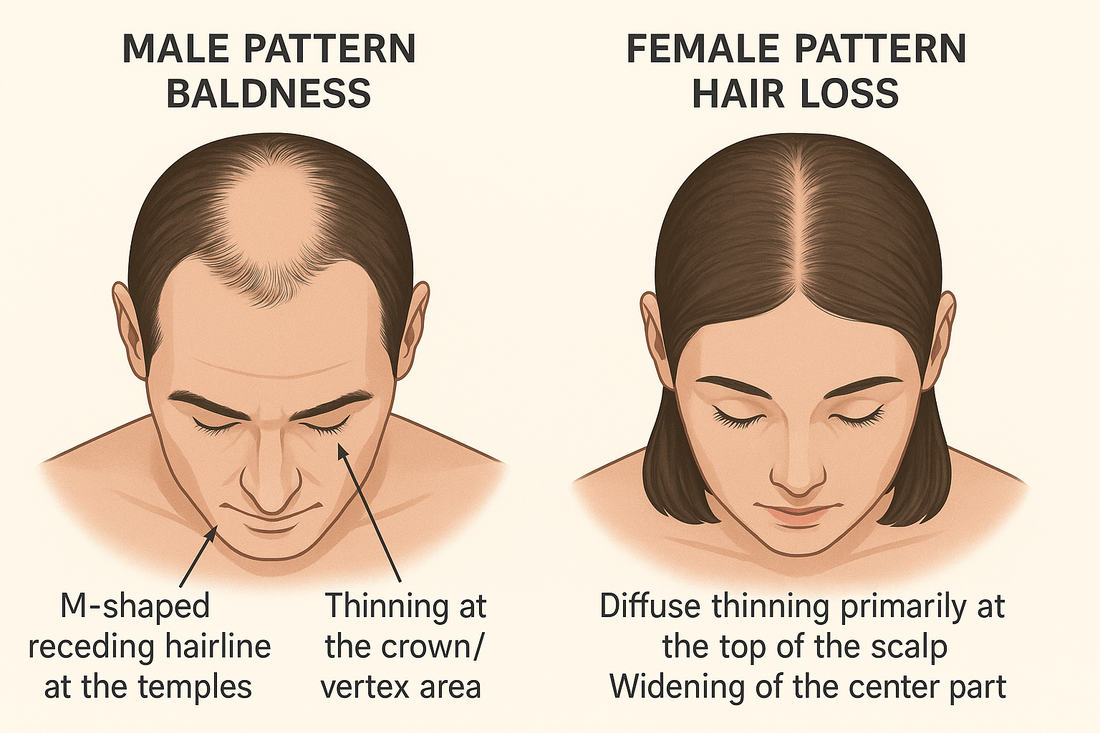Hair loss is one of the most common concerns I see in clinic — and for many, it’s also one of the most emotionally challenging. Understanding why it happens is the first step toward taking control and finding the right treatment plan.
What Is Androgenetic Alopecia?
Androgenetic alopecia (AGA), often known as male or female pattern hair loss, is a genetically driven condition where hair follicles gradually shrink (miniaturise) over time. This shrinking process shortens the growth phase of the hair cycle, resulting in finer, shorter, and eventually non-growing hairs.
The key culprits? Genetics and androgens (hormones such as dihydrotestosterone, or DHT). These factors influence how susceptible each follicle is to the miniaturisation process — which is why some people experience noticeable thinning while others never do.
The Difference Between Male and Female Patterns
Although the underlying mechanism is similar, the patterns of loss look quite different:
-
Men often experience receding hairlines and thinning at the crown, which can progress into more extensive baldness over time.
-
Women usually notice a widening parting or general thinning on the top of the scalp, but the frontal hairline is typically preserved.
Recognising these patterns early is key — because the sooner you act, the better the outcome.
Why You Should See a Clinical Trichologist
Before trying any product, supplement, or considering surgical options, it’s essential to understand what’s actually happening on your scalp.
A Clinical Trichologist is trained to assess scalp health, identify the type and stage of hair loss, and create a targeted treatment plan that addresses both the symptoms and the underlying causes.
Hair loss is rarely just about hair — it’s about hormones, nutrition, inflammation, scalp health, and lifestyle too.
What About Hair Transplants?
Hair transplants can be life-changing for the right person — but they’re not a “fix and forget” procedure. During a transplant, follicles from areas resistant to DHT (usually the back of the head) are moved to thinning areas.
However, if androgens remain active and untreated, the newly transplanted hairs — and surrounding native hairs — can still miniaturise and shed.
Without a long-term management plan from a Clinical Trichologist or specialist, the results can fade over time.
Systemic Treatments: Know the Risks
Drugs like finasteride and dutasteride can reduce DHT levels and slow down hair loss, but they come with well-documented systemic side effects — from hormonal imbalances to mood changes and sexual dysfunction.
That’s why it’s crucial to understand the “why” before committing to any complex treatment or procedure. The goal isn’t just to regrow hair — it’s to restore balance and maintain long-term scalp health safely.
The Takeaway
A hair transplant or topical product won’t change your genetics — but the right diagnosis, scalp care, and management plan can make all the difference.
If you’re noticing thinning, widening, or receding — don’t panic and don’t self-diagnose. Reach out to a qualified Clinical Trichologist who can help you understand the cause, protect your remaining hair, and plan a realistic path forward.
💡 Want to Help Others?
If this post helped you, share it with someone who’s struggling with hair loss. Awareness and early intervention really do make a difference.

